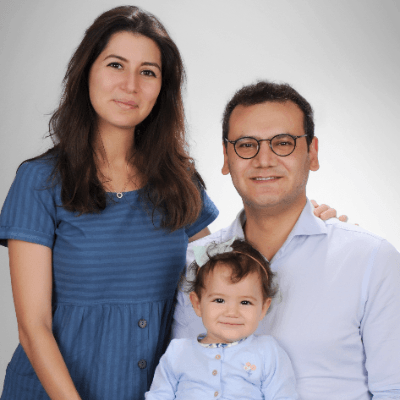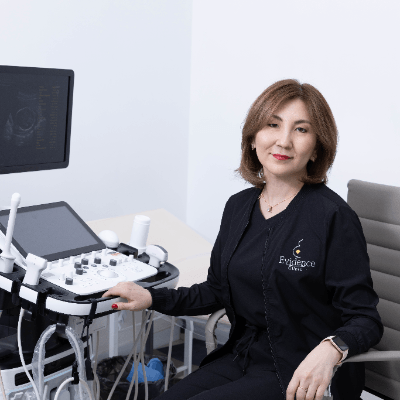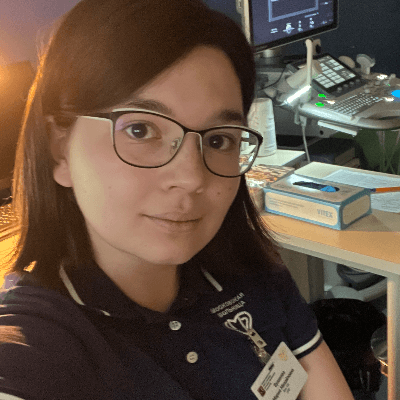Case of the Week #636
(1) Department of Genetics, Polish Mother's Memorial Hospital, Lodz, Poland; (2) Medical Genetics Department - Institute of Mother and Child, Warsaw, Poland; (3) Centro Médico Recoletas, Valladolid, Spain
View the Answer Hide the Answer
Answer
We present a case of first trimester diagnosis of Caudal Regression Syndrome.
Our ultrasound demonstrated the following:
- Trunk shortening relative to limbs, with overall disproportion. Crown-rump-length equivalent to 12+4 weeks and biparietal diameter corresponding to 12+6 weeks.
- Juxtaposed iliac bones, abnormally close together in the axial plane.
- The sacrum was not visualized with the lower spine ending abruptly and tapering irregularly, suggesting agenesis.
- The anus was visualized in the transverse plane and there was no dilation of the rectum or distal colon, suggesting a patent anus.
- Non-visualization of nasal bones
- Lateral neck cyst
Despite the early gestational age, these findings were suggestive of caudal regression syndrome, a rare congenital disorder characterized by developmental failure of the caudal part of the spine and associated structures. The unossified nasal ridge and lateral neck cyst are not typically associated with caudal regression syndrome and probably represented incidental findings. Array comparative genomic hybridization (a-CGH) microarray performed on chorionic villous sampling was normal.
Discussion
Caudal Regression Syndrome, also known as caudal regression sequence, caudal dysplasia/aplasia, or sacral agenesis, is a spectrum of anomalies involving the caudal end of the trunk [1]. It is a congenital malformation involving the lower spine segments of the vertebral column characterized by a truncated medullar cone and aplasia or hypoplasia of the sacrum, with variable involvement of the gastrointestinal, genitourinary, skeletal and nervous systems. Agenesis of the lumbosacral spine was first described by Hohl in 1852 [2]. More than a century later, Bernard Duhamel, a French pediatric surgeon, coined the term “syndrome of caudal regression” to describe a spectrum of malformations ranging from anal atresia with anomalies of the lumbosacral spine, lower limbs, urinary and genital systems to the most severe form with fusion of the lower extremities (sirenomelia) [3]. Its frequency is estimated to be 1.3 in 10,000 births [1], occurring more frequently in infants of diabetic mothers than in the general population. Although diabetic mothers are 200 times more likely to deliver a neonate with caudal regression syndrome, only 16-22% of infants with caudal regression syndrome are born to women with pregestational diabetes [4,5].
The pathogenesis involves abnormal differentiation of the developing caudal mesoderm (spine, spinal cord, and lower limbs) before the fourth week of fetal development. Migration of the primitive streak, primary and secondary neurulation, or differentiation of the embryonic layers can be compromised [6]. Caudal regression syndrome is likely caused by a combination of factors including genetic disposition and a developmental insult. The most common teratogen involved in this process is hyperglycemia in diabetic mothers with poor glycemic control [7,8]. Other possible contributing factors include vascular anomalies altering blood flow, and drug exposure such as retinoic acid in animal research, and minoxidil and trimethoprim-sulfamethoxazole in clinical care [9,10]. The karyotype is usually normal and, although caudal regression syndrome has been linked to mutations in the HLXB9 homeobox gene, this has not been confirmed in subsequent studies [11].
Postnatally, characteristic features of sacral agenesis include a short intergluteal cleft, flattened buttocks, narrow hips, distal leg atrophy, and talipes deformities with urinary and bowel dysfunction. Neurologically, lumbosacral motor functions are often compromised more than sensation, and urinary and bowel dysfunction are universal. Neurologic deterioration is frequently associated with tethered cord [12]. In fetal life, a modification of Renshaw's classification of sacral agenesis is used, and includes three types: type 1, partial or total unilateral sacral agenesis; type 2, partial but bilateral and symmetrical sacral agenesis; and type 3, total sacral agenesis [13].
Classic findings on prenatal ultrasound are sudden interruption of the spine at various levels (coccygeal, sacral, lumbar, and even inferior thoracic vertebrae) with absence of vertebrae and frog-leg position of the lower limbs, also termed cross-legged tailor or Buddha pose [1,14]. Complete or partial agenesis of the sacrum and lumbar vertebrae associated with hypoplastic, fused iliac blades in the midline gives a shield-like appearance. A decreased distance between the femoral heads, and an unchanging position of fetal femurs during sonographic examination is suggestive of this abnormality. Although caudal regression syndrome may be best visualized on sagittal imaging, axial or coronal views of the fetal spine (facilitated by 3D and 4D ultrasound) also show a lack of bony ossification centers at the level of the iliac wings [15]. Associated anomalies are common, involving abnormalities of the genitourinary tract (vesicoureteral reflux, hydronephrosis, fused kidneys, renal agenesis, ectopic ureters, and transposition of external genitalia), gastrointestinal system (anorectal atresia, abdominal wall defects, gut malrotation, and imperforate anus), cardiac, and respiratory systems [16]. These were not seen in our case. Since S1–S2 ossification nuclei are visualized at 16 to 17 weeks of gestation during normal fetal development, caudal regression syndrome is usually diagnosed from 18 weeks onwards when these findings are absent [17]. First-trimester ultrasound findings suggestive of the diagnosis include short crown-rump length, protuberance of the lower spine, and non-visualization of the sacral spinal segment with the iliac bones seen in close proximity to each other [18,19]. Fukada et al report a case of increased nuchal translucency in a fetus with caudal regression syndrome, however this may be a coincidental finding [20]. Magnetic resonance imaging (MRI) may be a useful adjunct to confirm the diagnosis, particularly in the setting of oligohydramnios and maternal obesity when ultrasound imaging may be suboptimal. Additionally, MRI may more accurately identify the level of the conus medullaris and associated anomalies [21].
Differential diagnosis for caudal regression syndrome includes arthrogryposis-akinesia (mimics mild caudal regression syndrome but the spine is normal), myelomeningocele (presents an Arnold-Chiari malformation type 2), the Currarino triad, and sirenomelia [1]. Caudal regression syndrome may be associated with a pattern of anomalies such as VATER/VACTERL (Vertebral defects, Anal atresia, Cardiac defects, Tracheo-Esophageal fistula, Radial and renal dysplasia, and Limb abnormalities) or OEIS (Omphalocele, Exstrophy, Imperforate anus, and Spinal defects) association. The Currarino triad is a related, yet distinct condition that includes anorectal atresia or ectopia, hemisacral agenesis, and a presacral lesion such as anterior meningocele, lipoma or dermoid cyst [22]. Sirenomelia involves a single fused lower extremity and is now usually considered a separate entity from caudal regression syndrome with a different etiology. In sirenomelia, the vascular steal phenomenon (called single umbilical artery type II) maintains that an aberrant vessel derived from the vitelline artery replaces the umbilical arteries, which are normally derived from the internal iliac arteries, and shunts blood from the abdominal aorta directly through the umbilical cord to the placenta, causing severe ischemia of the caudal portion of the fetus [23].
There is no intrauterine treatment for caudal regression syndrome, so prevention should focus on identifying patients with diabetes, preconception counseling, and optimizing glycemic control (glycosylated hemoglobin A1c <6.5%) in the periconceptional and embryogenic periods. After diagnosis, subsequent management depends on gestational age at diagnosis, severity of the primary lesion, associated anomalies, and parental wishes, considering interruption of pregnancy in its early stages [1].
References
1. Krakow D. Caudal Regression Syndrome. In: Obstetric Imaging: Fetal Diagnosis and Care, third edition. Copel J, ed. Elsevier, Philadelphia, PA, USA, 2026; pages 494a-497e1.
2. Hohl AF. Zur Pathologie des Beckens. I. Das schräg-ovale Becken, S. Wilhelm Engelmann, Leipzig, 1852; pp 61-63.
3. Duhamel B. From the Mermaid to Anal Imperforation: The Syndrome of Caudal Regression. Arch Dis Child. 1961 Apr;36(186):152-155.
4. Garne E, Loane M, Dolk H, et al. Spectrum of congenital anomalies in pregnancies with pregestational diabetes. Birth Defects Res A Clin Mol Teratol. 2012 Mar;94(3):134-140.
5. Kokrdova Z. Caudal regression syndrome. J Obstet Gynaecol. 2013 Feb;33(2):202-203.
6. Stroustrup Smith A, Grable I, Levine D. Case 66: caudal regression syndrome in the fetus of a diabetic mother. Radiology. 2004 Jan;230(1):229-233.
7. Cousins L. Congenital anomalies among infants of diabetic mothers. Etiology, prevention, prenatal diagnosis. Am J Obstet Gynecol. 1983 Oct 1;147(3):333-338.
8. Boardley E, Shanks AL, Thada PK, Khattar D. Diabetic Embryopathy. 2025 Jun 10. In: StatPearls [Internet]. Treasure Island (FL): StatPearls Publishing; 2025 Jan.
9. Warner T, Scullen TA, Iwanaga J, et al. Caudal Regression Syndrome-A Review Focusing on Genetic Associations. World Neurosurg. 2020 Jun;138:461-467.
10. Rojansky N, Fasouliotis SJ, Ariel I, Nadjari M. Extreme caudal agenesis. Possible drug-related etiology? J Reprod Med. 2002 Mar;47(3):241-245.
11. Merello E, De Marco P, Mascelli S, et al. HLXB9 homeobox gene and caudal regression syndrome. Birth Defects Res A Clin Mol Teratol. 2006 Mar;76(3):205-209.
12. Pang D. Sacral agenesis and caudal spinal cord malformations. Neurosurgery. 1993 May;32(5):755-778.
13. Mottet N, Martinovic J, Baeza C, et al. Think of the Conus Medullaris at the Time of Diagnosis of Fetal Sacral Agenesis. Fetal Diagn Ther. 2017;42(2):137-143.
14. Zheng Y, Li L, Wang L, Zhang C. The clinical value of prenatal ultrasound in the diagnosis of caudal regression syndrome. Am J Transl Res. 2023 Mar 15;15(3):1982-1989.
15. Bashiri A, Sheizaf B, Burstein E, et al. Three dimensional ultrasound diagnosis of caudal regression syndrome at 14 gestational weeks. Arch Gynecol Obstet. 2009 Sep;280(3):505-507.
16. Adra A, Cordero D, Mejides A, et al. Caudal regression syndrome: etiopathogenesis, prenatal diagnosis, and perinatal management. Obstet Gynecol Surv. 1994 Jul;49(7):508-516.
17. De Biasio P, Ginocchio G, Aicardi G, et al. Ossification timing of sacral vertebrae by ultrasound in the mid-second trimester of pregnancy. Prenat Diagn. 2003 Dec 30;23(13):1056-1059.
18. González-Quintero VH, Tolaymat L, Martin D, et al. Sonographic diagnosis of caudal regression in the first trimester of pregnancy. J Ultrasound Med. 2002 Oct;21(10):1175-1178.
19. Kaur L, Singh D, Kaur MP et al. First Trimester Sonographic Findings of Caudal Regression Syndrome. J. Fetal Med. 2017;4:47–49.
20. Fukada Y, Yasumizu T, Tsurugi Y, et al. Caudal regression syndrome detected in a fetus with increased nuchal translucency. Acta Obstet Gynecol Scand. 1999 Aug;78(7):655-656.
21. Mahmoud MH, Asghar T, Elkammash TH, et al. Fetal Magnetic Resonance Imaging in Association With Antenatal Ultrasound in the Diagnosis of Caudal Dysgenesis: Report of Two Cases. Cureus. 2023 Feb 26;15(2):e35485.
22. Friedmann W, Henrich W, Dimer JS, et al. Prenatal diagnosis of a Currarino triad. Eur J Ultrasound. 1997 Dec 1;6(3):191-196.
23. Stevenson RE, Jones KL, Phelan MC, et al. Vascular steal: the pathogenetic mechanism producing sirenomelia and associated defects of the viscera and soft tissues. Pediatrics. 1986 Sep;78(3):451-457.
Discussion Board
Winners

Dianna Heidinger United States Sonographer

Javier Cortejoso Spain Physician

Andrii Averianov Ukraine Physician

Alexandr Krasnov Ukraine Physician

Mayank Chowdhury India Physician

Marianovella Narcisi Italy Physician

Elena Andreeva Russian Federation Physician

Murat Cagan Turkey Physician

ANA PAULA PASSOS Brazil Physician

gholamreza azizi Iran, Islamic Republic of Physician

Kareem Haloub Australia Physician

Arati Appinabhavi India Physician

YULIA VISHNEVSKAYA Russian Federation Physician

Amy Scheible United States Sonographer

Denys Saitarly Israel Physician

Tetiana Ishchenko Ukraine Physician

Almudena Martín García Spain Physician

Ali Ozgur Ersoy Turkey Physician

Viktorya Mkrtchyan Armenia Physician

ZHANNA Kurmangaliyeva Kazakhstan Physician

Dubyanskaya Yuliya Russian Federation Physician

Victoria Zagidullina Russian Federation Sonographer

Maria Bulanova Russian Federation Physician

Geeta Kulkarni India Maternal Fetal Medicine Consultant

Griselda Mariel Vides Argentina Physician

Genevieve Mika United States Sonographer

Ryan Findlay United States Physician